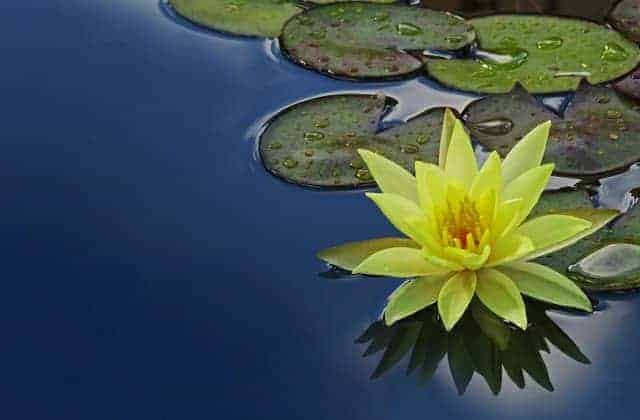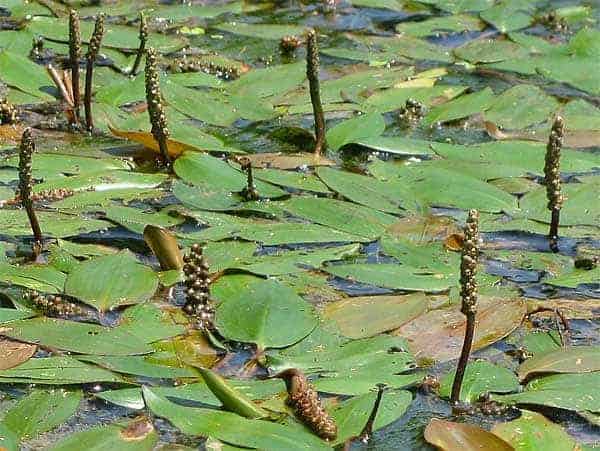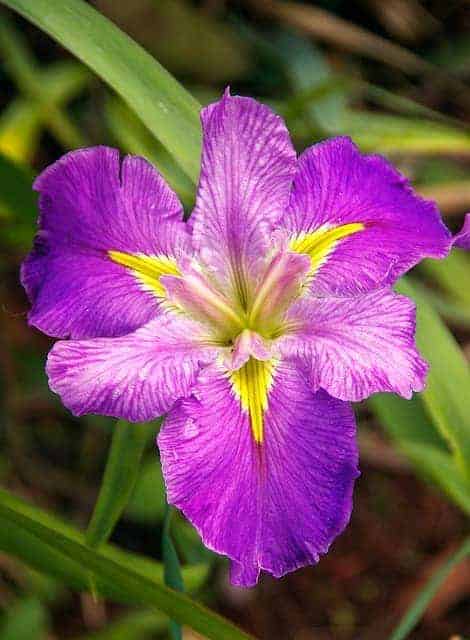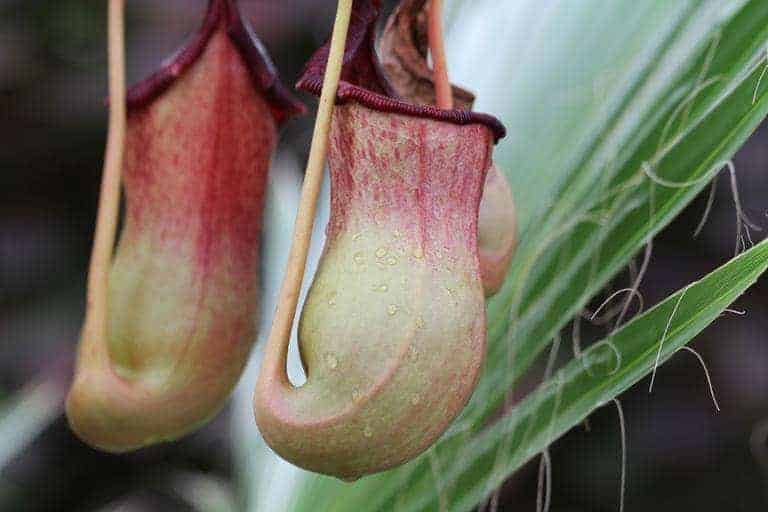There are countless ways to use landscape design to enhance your property. Among those many options, a garden pond is one of the most intriguing elements you can add to your yard. The challenge with these ponds is that it takes a considerable amount of ongoing maintenance to keep them clean.
Fortunately, the plants that you grow in your pond can be highly effective in filtering the water and keeping your pond environment pristine. In this article, we will highlight the importance of these plants then show you a few examples of the best plants for pond filtration.

Pond Plants for Beginners
Shortly, we will introduce you to some specific varieties of pond plants that will help with filtration. But before we do, we thought it would be helpful to cover some of the general reasons why these plants are so vital.
To a beginner gardener, it may seem that there is no discernable reason why a pond would need plants. However, the truth is that plants are a nonnegotiable feature of a garden pond in most cases. While aerators and man-made filters are an essential component of an artificial pond, plants offer several additional advantages by:
- Filtering pollutants and other harmful substances
- Controlling algae blooms
- Supporting wildlife and aquatic ecosystems
- Improving oxygen levels in pond water
- Reducing shoreline erosion
- Providing cover for fish and other animals
- Enhancing the appearance of the pond area
Those benefits make it easy to see why every garden pond should be home to a wide array of aquatic plant life. With that point established, let us approach the topic of pond plant selection.
What Water Plants Are Good for Ponds?
Later on, you will learn that there are many different individual varieties of pond plants. That wide variety gives you a lot to choose from but can be a bit overwhelming. To help you gain a sense of direction for your pond planting scheme, you should become familiar with a few of these broad groups of pond plants:
- Floating pond plants
- Submerged pond plants
- Emergent pond plants
- Marginal pond plants
- Bog pond plants
Plants in each of those categories thrive in different areas of your pond. However, at times it is hard to determine where one category ends, and another begins. As you will see, some plant species could reasonably belong to more than one of the groups we just listed.
Hopefully, the next few sections will give you some clarity and a better idea of where each of these kinds of plants belongs in your pond. We will also mention a few of the most common plant species in each group.

Floating Water Plants

Floating pond plants can be extremely alluring while playing a critical role in keeping your pond clean. The visible portions of these plants sit at the water’s surface and often boast pleasing flowers and leaves.
At times, these species may have root systems that reach through the deepest parts of your pond and connect with the soil below. That characteristic can make it difficult to draw a clear distinction between floating plants and the emergent plants we will cover later. Other versions of floating pond plants have root systems that float as well with no attachment to the soil.
One of the main benefits of these plants is that they provide shade for your pond. Without that shade, the unabated sunlight would promote the growth of algae in your pond water.
One of the only drawbacks of these plants is that they reproduce so quickly that they can dominate your pond area easily. With that in mind, consider adding these floating plants to your garden pond:
- Mosquito fern
- Water hyacinth
- Water lilies
- Lotuses
- Water lettuce
- Floating pennywort
FURTHER READING
- Water Lily vs. Lotus – What’s the Difference?
- A Simple DIY Method to Create a Backyard Koi Pond
- How to Grow Lily Pads in a Pond
- 13 Beautiful Backyard Pond Ideas [with Pictures!]
Recommended Floating Plants
Pond Plants that Live Underwater
Submerged pond plants are plant species that live entirely underwater. These plants may not add much to the appearance of your pond, but they remain extremely valuable for another reason.
Since submerged plants live underwater, they are in direct competition with the algae that you are trying to stifle. Submerged plants also do a great job of oxygenating your pond water.
The presence of oxygen is what allows fish and certain bacteria to survive in your pond. While a high volume of bacteria may not seem like a desirable outcome, that same bacteria is responsible for decomposing any algae or sludge that might otherwise contaminate your pond.

Submerged plants also need to take all their nutrients from the surrounding water. That need is what causes these plants to absorb and filter any pollutants in the water as well. For those reasons, submerged plants should have a home in your pond. Here are some of the species you should look at:
- Mermaid plant
- Mint Charlie
- Parrot’s feather
- American pondweed
- Eelgrass
- Hydrilla
Emergent Water Plants
Emergent pond plants are somewhat like submerged pond plants. For instance, both emergent and submerged plants take root in the soil below the surface of the water. The difference is that emergent plants grow up through the surface of the water as well.
Plants in this category come in many shapes and sizes and include some of the most iconic aquatic species. These species send stems and leaves into the air, sometimes as much as six feet above the water’s surface.
Like the other pond plants we have mentioned so far, emergent pond plants intake nutrients from the pond and filter the water simultaneously. They can also make an impressive visual impact on your pond landscape.
Plants that belong in the emergent category are some of the most recognizable pond plants around. Here are a few of the ones that you should think of growing in your pond:
- Cattails
- Water lilies
- Pickerelweed
- Bullrushes
- Arrowheads
- Elephant ear

Pond Plants for Shallow Areas
We have now covered the types of plants that can live in water that is relatively deep. Now, we will move on to some plants that are suitable for the shallow waters near the edge of your pond.
Marginal pond plants can live in water depths that range from zero inches to about half a foot. That means that these plants can either live directly in the water or just outside of the water.
Since marginal pond plants have less contact with your pond, they will also have less of a filtration effect. However, these plants will still make some contribution to keeping your pond clean.

Marginal plants live at the transition point between the pond water and the shoreline. They are also capable of adding both design and ecological value to your pond landscape. Here are some of the plants that are ideal for that setting:
- Aquatic irises
- Zebra rush
- Marsh marigold
- Bur reed
- Water plantain
- Water arum
Bog Plants
Our final category of pond plants shares a close relationship with the last one. In fact, many of the marginal pond plants are also bog plants.
It is no surprise to find that bog plants are a suitable addition to your pond planting scheme. The natural settings in which these species grow are incredibly like your pond environment.
The main necessity for bog plants is water that remains wet continuously. That constant moisture is what allows bog plants to remain healthy and thrive in their environment. However, unlike marginal plants, bog plants typically have a lower tolerance for growing directly in pond water.

For that reason, bog plants may not be the best for pond filtration as they need to live outside of the water. However, these plants still contribute to the overall health of your pond by supporting wildlife. Bog plants are also a helpful tool as you try to incorporate your pond into your property’s existing landscape design. Here are a few of the best bog plants you can use for that purpose:
- Cardinal flower
- Canna lily
- Taro
- Pitcher plants
- Giant Brazilian rhubarb
- Gotu kola
Recommended Bog Plant
A Few Pond Plant Tips
You now know some of the broadest pond plant categories and a few species that fit within each one. That knowledge alone should set you on the right track towards creating a lush pond planting plan. However, before we conclude, we thought it would be helpful to share a few more pond planting tips.
Dirt for Pond Plants
If you have never planted a pond plant, you may wonder what soil is best to use. Since pond plants live in a specific setting, they also require a specific variety of soil.
In general, it is best to plant your pond plants in heavy clay soil. These soils are less likely to have their nutrients float away in the water.
Respect Growing Conditions
As is the case with any plant you intend to grow, you need to understand the growing requirements for each pond plant you select. For instance, you will find that some pond plants are cold hardy while others are not.
You pond plant will only succeed in a setting that meets their needs. So, make sure you pay special attention to the care conditions that each species calls for.
Complement Your Existing Landscape
Our last tip is to use your pond landscape to complement the rest of your property. Before you create your pond, envision how it will relate to any nearby patio spaces or other notable landscape elements. Doing so will help to ensure that your pond will improve the experience of spending time in your yard.
Sources:
Pond plants are a vital part of a balanced aquatic ecosystem
How to Maintain Healthy Pond Oxygen Levels

John Haryasz is a freelance writer and landscape designer. In the field of landscape architecture, he has contributed to many successful design projects throughout the country. As a writer, John specializes in creating captivating and informative web content. Through that work, he aims to share his design knowledge and promote engagement with the outdoor world.

![How to Water Indoor Plants [Plant Care 101]](https://wraxly.com/wp-content/uploads/2021/03/How-to-Water-Indoor-Plants-Plant-Care-101-1200-1024x576.webp)

![Growing Plants from Cuttings [A Simple Guide]](https://wraxly.com/wp-content/uploads/2021/03/Growing-Plants-from-Cuttings-A-Simple-Guide-1200-1024x576.webp)